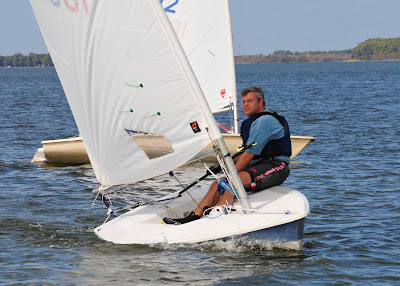CAPSIZE AND HIGH WIND ADVICE.
If your life jacket can catch on the boom, then wear a shirt over the jacket to hold it down.
If you fall out of the boat, let go of the tiller extension and hold onto the sheet. You can pull on the sheet to get back to the boat and don’t have to swim after the boat.
Don’t sail alone on windy days.
To Manage storms. 1) Turn down the boat and sit on the high side until the wind gets lighter. Then right the boat and sail home.
2) If home is down wind, let the sail out in front of the boat and let it luff, while you broad reach or run under control. If you have standard sheet, you will have to untie the knot at the end, pass the end through the racket block and retie the end. If you don’t retie the sheet will run out and hard to get back. If you have the knot at the boom block, you can change your mind about sail direction. You can head up and get the sheet end back. If you have a 50 foot sheet you can let the sail all the way out without fooling with the end, but you have to put up with the extra 4 to 6 feet of line in the bottom of the boat the rest of the time.
3) If you need to go upwind in survival situation, get the vang all the way off or unhook it so when you ease the sheet a little the boom will rise. Then close reach back and forth, driving the boat with the bottom half of the sail full and the top in a luff.
Tacking in high winds 1) Be moving fast when you begin the tack. 2) Tack in a flat spot or on the down side of a wave. 3) Turn fast to a close reach, hike, trim in and then get back to close-hauled. 4) If caught in irons, fall off to almost beam reach, trim in fast and try and get going before the wind cranks you back into irons again.
UP WIND AND DOWNWIND.. Try to keep the boat balanced– near flat. If a gust makes you heel, ease the sheet to keep flat before the end of the boom hits the water (too Late). If the boat heels to windward, trim in and bear off or both.
When on a run or reach and fast planing, get the board half way up. A full board can plane up to the surface if it gets a little angle.
When planing move as far back in the boat as you can to get on the more stable stern sections and the bow up.
When on a reach or a run, control the heel by sheeting in or out. If a gust catches you, heeling and forcing you up, sheet out to flatten the boat and gain control.
On a run you are more stable by the lee. Keep the boom in at 70 or 80 degrees from hull midline. You may want to put an extra knot is the sheet there so it won’t go out further if you drop the sheet. Not too much vang as you want some twist at the top of the sail to help prevent accidental gybe.
By the lee is a little more stable, but dead downwind can be really unstable. So go downwind by the lee or broad reaching.
If the boat heels too much to windward, turn the boat toward the boom with the rudder. This will tend to sink the transom and twist the boat more upright. The worst that will happen is a gybe. Don’t try to head up, like some of us did years ago.
The “death roll” happens when the top of the sail get pointed to windward and starts the boat rolling, and then the apparent wind at the top of the mast kicks in and accelerates the capsize to windward. “Death roll” because it happens so quickly it is hard to control. When the roll starts turn the boat toward the boom with the rudder – see “if the boat heels too much to windward” above.
Now if you turn over to windward and are righting the boat, think about holding onto the centerboard as the boat rights, going under the boat and coming up on the windward side to again right the boat or to just get in. (The San Francisco roll)
In Lake Eustis we have especially sticky mud in the bottom at about 12 feet deep. If you get you mast head into it, it may take two people on the centerboard to get it free or a motor boat to pull the bow forward and downwind.
In general, it takes PRACTICE to make these adjustments and keep the boat level. If you get over a little the boom can quickly get in the water. Time then, to practice “right the boat”
.
To practice in higher winds you might want to try the 4.7 and radial and to work your way up to full rig..
.










